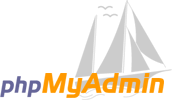 phpMyAdmin is a free software tool written in PHP intended to handle the administration of MySQL over the World Wide Web. phpMyAdmin supports a wide range of operations with MySQL. The most frequently used operations are supported by the user interface (managing databases, tables, fields, relations, indexes, users, permissions, etc), while you still have the ability to directly execute any SQL statement.
phpMyAdmin is a free software tool written in PHP intended to handle the administration of MySQL over the World Wide Web. phpMyAdmin supports a wide range of operations with MySQL. The most frequently used operations are supported by the user interface (managing databases, tables, fields, relations, indexes, users, permissions, etc), while you still have the ability to directly execute any SQL statement.
phpMyAdmin comes with a wide range of documentation and users are welcome to update our wiki pages to share ideas and howtos for various operations. The phpMyAdmin team will try to help you if you face any problem, you can use variety of support channels to get help.
phpMyAdmin is also very deeply documented in a book written by one of developers – Mastering phpMyAdmin for Effective MySQL Management, which is available in English, Czech and Spanish.
To ease usage to a wide range of people, phpMyAdmin is translated into 65 languages and supports both LTR and RTL languages.
Since version 3.0.0, phpMyAdmin joined the GoPHP5 initiative and dropped compatibility code for older PHP and MySQL versions; version 3 and later requires at least PHP 5.2 and MySQL 5.
phpMyAdmin has won several awards. Among others, it was chosen as the best PHP application in various awards and has won every year the SourceForge.net Community Choice Awards as “Best Tool or Utility for SysAdmins”.
phpMyAdmin is a thirteen-year-old project with a stable and flexible code base, to find out more about the project and its history see separate page.
Features
- Intuitive web interface
- Support for most MySQL features:
- browse and drop databases, tables, views, fields and indexes
- create, copy, drop, rename and alter databases, tables, fields and indexes
- maintenance server, databases and tables, with proposals on server configuration
- execute, edit and bookmark any SQL-statement, even batch-queries
- manage MySQL users and privileges
- manage stored procedures and triggers
- Import data from CSV and SQL
- Export data to various formats: CSV, SQL, XML, PDF, ISO/IEC 26300 – OpenDocument Text and Spreadsheet, Word, LATEX and others
- Administering multiple servers
- Creating PDF graphics of your database layout
- Creating complex queries using Query-by-example (QBE)
- Searching globally in a database or a subset of it
- Transforming stored data into any format using a set of predefined functions, like displaying BLOB-data as image or download-link
- And much more…
 I am Mumbai based
I am Mumbai based 
0 Comments.